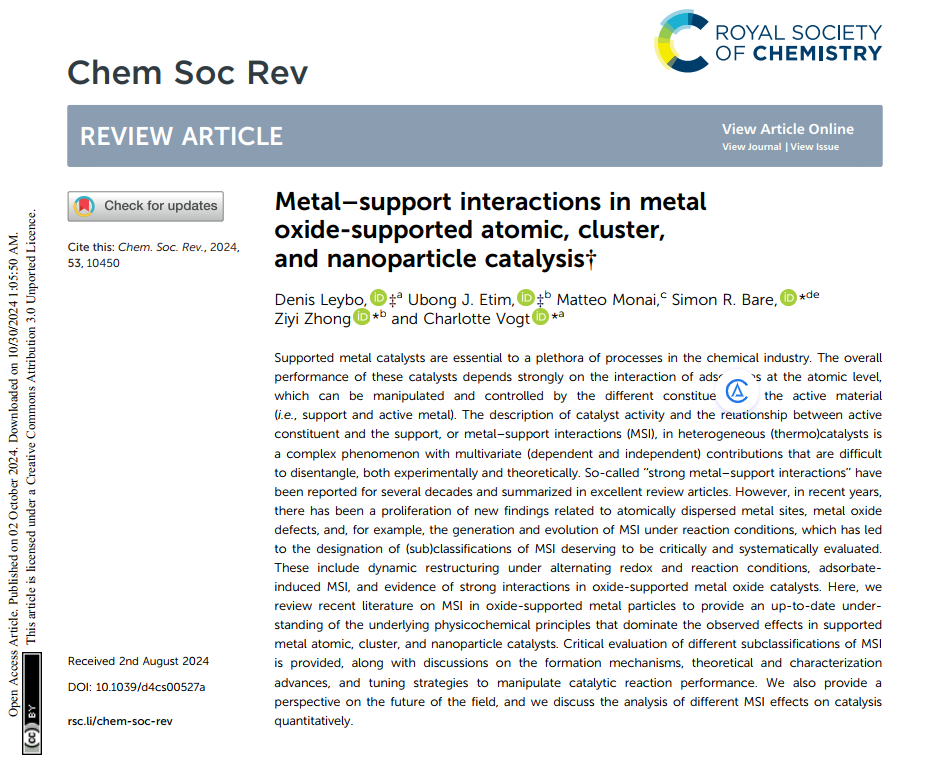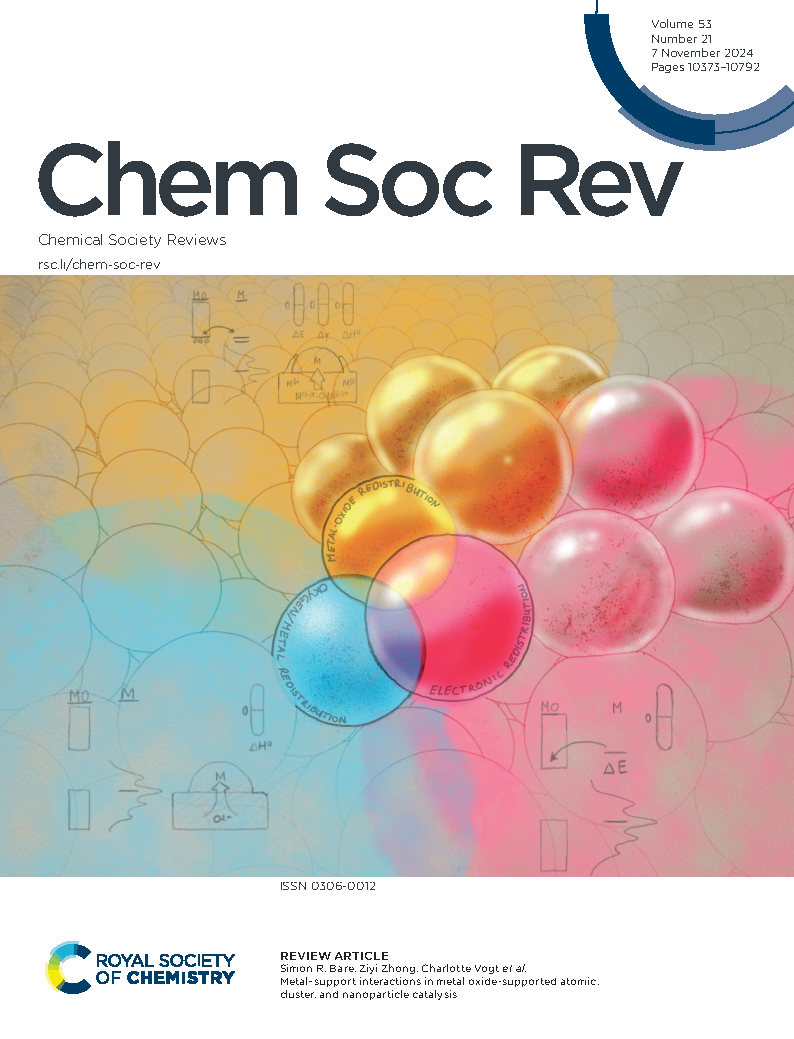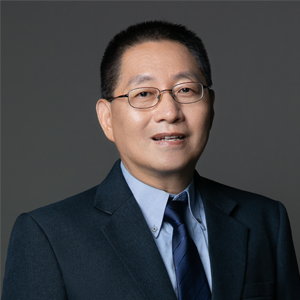PostTime:11/26/2024
Recently, the research group of Professor Ziyi Zhong at the Guangdong Technion - Israel Institute of Technology (GTIIT), the research group of Professor Charlotte Vogt at the Technion - Israel Institute of Technology, and Professor Simon R. Bare at Stanford University published a review titled “Metal–support interactions in metal oxide-supported atomic, cluster, and nanoparticle catalysis” in Chemical Society Reviews, a top international journal (IF=40.4). This article, the result of two years of scientific research, fully demonstrates the profound knowledge and achievements of GTIIT scholars in the field of chemical engineering, effectively expanding GTIIT's academic influence.

Journal Intro

Chemical Society Reviews is a top review journal under the Royal Society of Chemistry, belonging to the top-tier journals of the first-level discipline. It enjoys extremely high academic influence and authority in the fields of chemistry, chemical engineering, and materials science. The papers published in this journal play a significant leading and guiding role in the related fields.
Paper
DOI:
10.1039/D4CS00527A
Link: https://pubs.rsc.org/en/content/articlepdf/2024/cs/d4cs00527a
Research background
Catalysis is fundamental to the chemical industry, influencing around 80% of energy consumption and 75% of all greenhouse gas emissions. The two most widely used types of heterogeneous thermal catalysts in industry are supported metal catalysts (SMC) and solid acid catalysts. There is a very important phenomenon in SMC catalysts, namely strong metal-support interaction (SMSI). It was first discovered by Tauster et al. in the 1970s: reducible carriers such as TiO2 can migrate to the surface of metal particles at high temperatures, but non-reducible carriers have almost no such phenomenon. At that time, there were only occasional reports on research in this area, and these lacked depths. However, recent studies have uncovered various manifestations of Strong Metal-Support Interactions (MSI), as detailed in Table 1. These include electron-transfer MSI (EMSI) and covalent MSI (CMSI), which are connected through strong covalent bonds. Additionally, SMSI phenomena are also observed in non-reducing support SMC under special conditions, as well as MSI in single-atom catalysts.
SMSI profoundly affects the electronic properties and structure of the catalysts, thereby affecting their catalytic performance. Despite the relatively good literature in recent years, there still needs to be a more in-depth understanding of these complex SMSI phenomena, especially theoretical explanations.
Findings
In this review, the authors provided a comprehensive and in-depth analysis of SMSI, addressing several key issues: (1) proposed a comprehensive classification of SMSI; (2) In-depth mining of data in the literature, combined with semiconductor theory, conducted an in-depth theoretical analysis of the SMSI phenomenon; (3) Summarized the effects, control/design strategies, and characterization methods of SMSI; (4) Analyzed the effect of SMSI on catalysts' performances, such as stability, selectivity and activity; (5) Summarized and discussed future development directions and challenges to be overcome.
One of the features of this article is that for the first time, electronic structure parameters, such as Fermi level, work function, surface energy, metal oxide reducibility, adsorption heat, etc., are used to analyze the degree of strong interaction between metals and supports and to correlate the impact on catalytic reactions. SMSI will cause electron transfer, geometric structure adjustment, etc. For example, through the analysis of the difference in Fermi levels, semiconductor theory shows that electrons will migrate from metals with high Fermi levels to carriers with low Fermi levels or vice versa. This electron redistribution strengthens the binding force between the metal and the support, allowing for stronger interactions. For example, in the system of Fe and TiO?, due to the Fermi level difference, electrons are transferred from Fe to the conduction band of TiO?, thereby forming an electron-rich interface on the TiO? side, which plays an important role in catalytic activity.
SMSI's research results have broad application prospects in industrial catalysis, such as in CO? conversion, hydrogenation, dehydrogenation, and other processes. In the future, as the research on SMSI continues to deepen, scientists are expected to achieve efficient and green transformation of complex reaction systems through precisely designed SMSI catalysts and promote the sustainable development of catalytic science and human society.

Ziyi Zhong
Deputy Head of Chemical Engineering Program
Prof. Ziyi Zhong joined GTIIT in October 2018. He received his B.S. and M.S. degrees from Wuhan University and his Ph.D. from Nanjing University in China (1995). Later, he did 5-year postdoctoral research at Bar-Ilan University, the University of Washington at Seattle, and finally at the National University of Singapore. In 2002, he was awarded a Visiting Fellowship from NRC Canada and worked at an NRC Institute (BRI) in Montreal. During the period of 02/2003-09/2018, he worked at the Institute of Chemical and Engineering Sciences (ICES) under the Agency for Science, Technology and Research (A*STAR) in Singapore and also held an adjunct associate professorship in Nanyang Technological University (NTU) in Singapore (2013-2017), and a part-time position in Nanyang Environment and Water Research Institute (NEWRI) in NTU (2016-2018).
Before joining GTIIT, he worked on projects related to heterogeneous catalysis, material science, wastewater treatment, and pharmaceuticals, and some of the industrial projects were supported by companies such as Corning Inc (USA), Honeywell (U.S.), Mitsubishi Chemical Corp (Japan), MicroMil CarbonTech (Singapore) and Glaxo SmithKline plc (GSK), etc. He has authored/co-authored ca. 280 international journal papers (cited ca. 20800 times as of November, 2024, Google Scholar), 7 book chapters, and 10 granted patents (including 3 U.S. patents), with an h-index of 75 (Google Scholar). Also, he contributed ca. 30 technical project reports to the industry. (see his google scholar citation report: https://scholar.google.com/citations?user=qjIBW-QAAAAJ&hl=zh-CN&oi=ao)
At GTIIT, he established a Green Catalysis Laboratory to address scientific issues of heterogeneous catalysis, particularly the design and synthesis of nanocatalysts related to environmental catalysis; wastewater treatment; and surface chemistry.
Text/Photos: Ziyi Zhong, GTIIT News & Public Affairs
© GUANGDONG TECHNION-ISRAEL INSTITUTE OF TECHNOLOGY | 粤ICP备17036470号
